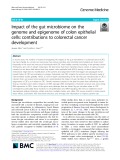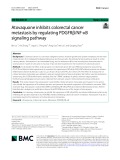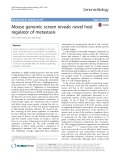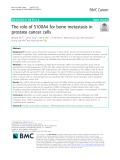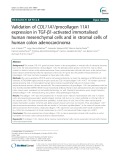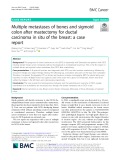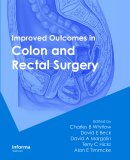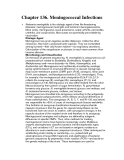
Distant colonization
-
In recent years, the number of studies investigating the impact of the gut microbiome in colorectal cancer (CRC) has risen sharply. As a result, we now know that various microbes (and microbial communities) are found more frequently in the stool and mucosa of individuals with CRC than healthy controls, including in the primary tumors themselves, and even in distant metastases.
 18p
18p  vibransone
vibransone
 28-03-2024
28-03-2024
 5
5
 2
2
 Download
Download
-
Colorectal cancer is a common malignant tumour. Invasive growth and distant metastasis are the main characteristics of its malignant biological behaviour, and they are also the primary factors leading to death in colon cancer patients. Atovaquone is an antimalarial drug, and its anticancer effect has recently been demonstrated in several cancer models in vitro and in vivo, but it has not been examined in the treatment of colorectal cancer.
 13p
13p  vialfrednobel
vialfrednobel
 23-12-2023
23-12-2023
 10
10
 2
2
 Download
Download
-
Tumor cells have to overcome challenges in the host tissue microenvironment to metastasize successfully to distant organs. In a recent Nature study, a genome-wide functional screen demonstrated that deficiency of the sphingosine-1-phoshate (S1P) transporter gene Spns2 in endothelium increased immune-mediated cell killing by T cells and natural killer (NK) cells, thereby suppressing metastatic colonization.
 3p
3p  vialfrednobel
vialfrednobel
 29-01-2022
29-01-2022
 13
13
 0
0
 Download
Download
-
Prostate cancers frequently metastasize to bone, where the best microenvironment for distant colonization is provided. Since osteotropic metastasis of prostate cancer is a critical determinant of patients’ survival, searches for preventive measures are ongoing in the field.
 13p
13p  vianrose2711
vianrose2711
 27-04-2021
27-04-2021
 18
18
 2
2
 Download
Download
-
Actinomycosis is a rare, chronic granulomatous disease caused by Gram-positive anaerobic bacteria that colonize the oral cavity. Cervicofacial actinomycosis is the most frequent clinical presentation of actinomycosis, but hematogenous osteomyelitis at distant sites can occur in rare instance in immunocompromised or pediatric patients, only a few cases have been reported in healthy patients.
 8p
8p  vivermont2711
vivermont2711
 28-01-2021
28-01-2021
 7
7
 2
2
 Download
Download
-
Conventional treatment for locally advanced rectal cancer usually combines neoadjuvant radiochemotherapy and surgery. Until recently, there have been limited predictive factors (clinical or biological) for rectal tumor response to conventional treatment. KRAS, BRAF and PIK3CA mutations are commonly found in colon cancers.
 6p
6p  vijennie2711
vijennie2711
 29-09-2020
29-09-2020
 12
12
 1
1
 Download
Download
-
Aggressive metastatic breast cancer cells seemingly evade surgical resection and current therapies, leading to colonization in distant organs and tissues and poor patient prognosis. Therefore, high-throughput in vitro tools allowing rapid, accurate, and novel anti-metastatic drug screening are grossly overdue.
 16p
16p  vilisa271
vilisa271
 22-09-2020
22-09-2020
 12
12
 1
1
 Download
Download
-
The human COL11A1 gene has been shown to be up-regulated in stromal cells of colorectal tumours, but, so far, the immunodetection of procollagen 11A1, the primary protein product of COL11A1, has not been studied in detail in human colon adenocarcinomas.
 12p
12p  vilisa271
vilisa271
 22-09-2020
22-09-2020
 10
10
 0
0
 Download
Download
-
The prognosis of ductal carcinoma in situ (DCIS) is reportedly well. Extremely rare patients with DCIS develop distant breast cancer metastasis without locoregional or contralateral recurrence. This is the first report of multiple bones and sigmoid colon metastases from DCIS after mastectomy.
 5p
5p  vikuala271
vikuala271
 13-06-2020
13-06-2020
 12
12
 1
1
 Download
Download
-
Phytoplasmas are plant pathogenic prokaryotes lacking cell wall, inhabiting phloem sieve elements in infected plants and have a unique life cycle among pathogens as they invade organisms of two distinct kingdoms, namely Plantae (plants) and Animalia (insects) and replicate intracellularly in both of them. Effectors are proteins secreted by a microbial pathogen into a host cell to enhance colonization and facilitate multiplication of the pathogens. In plants these effectors unload from the phloem to access distant tissues and alter basic developmental processes.
 13p
13p  cothumenhmong4
cothumenhmong4
 25-03-2020
25-03-2020
 9
9
 1
1
 Download
Download
-
A 65-year-old hypertensive male smoker requires a low anterior resection for treatment of an upper rectal cancer. A CT scan of the chest, abdomen, and pelvis does not show any distant metastatic spread and his carcinoembryonic antigen is normal. What additional preoperative laboratory studies and adjunctive testing are indicated? case management A complete history and physical examination is perhaps the single most important step for guiding preoperative preparation.
 420p
420p  ozon_ozon
ozon_ozon
 26-04-2012
26-04-2012
 58
58
 8
8
 Download
Download
-
Neisseria meningitidis is the etiologic agent of two life-threatening diseases: meningococcal meningitis and fulminant meningococcemia. More rarely, meningococci cause pneumonia, septic arthritis, pericarditis, urethritis, and conjunctivitis. Most cases are potentially preventable by vaccination. Etiologic Agent Meningococci are gram-negative aerobic diplococci. Unlike the other neisseriae, they have a polysaccharide capsule. They are transmitted among humans—their only known habitat—via respiratory secretions.
 19p
19p  ozon_ozon
ozon_ozon
 26-04-2012
26-04-2012
 51
51
 2
2
 Download
Download
-
Pathogenesis Hib strains cause systemic disease by invasion and hematogenous spread from the respiratory tract to distant sites such as the meninges, bones, and joints. The type b polysaccharide capsule is an important virulence factor affecting the bacterium's ability to avoid opsonization and cause systemic disease. Nontypable strains cause disease by local invasion of mucosal surfaces. Otitis media results when bacteria reach the middle ear by way of the eustachian tube. Adults with chronic bronchitis experience recurrent lower respiratory tract infection due to nontypable strains.
 5p
5p  colgate_colgate
colgate_colgate
 21-12-2010
21-12-2010
 78
78
 5
5
 Download
Download
-
Transgenic Mice as Models of Genetic Disease Several organisms have been studied extensively as genetic models, including Mus musculus (mouse), Drosophila melanogaster (fruit fly), Caenorhabditis elegans (nematode), Saccharomyces cerevisiae (baker's yeast), and Escherichia coli (colonic bacterium). The ability to use these evolutionarily distant organisms as genetic models that are relevant to human physiology reflects a surprising conservation of genetic pathways and gene function.
 6p
6p  konheokonmummim
konheokonmummim
 03-12-2010
03-12-2010
 90
90
 2
2
 Download
Download
CHỦ ĐỀ BẠN MUỐN TÌM








